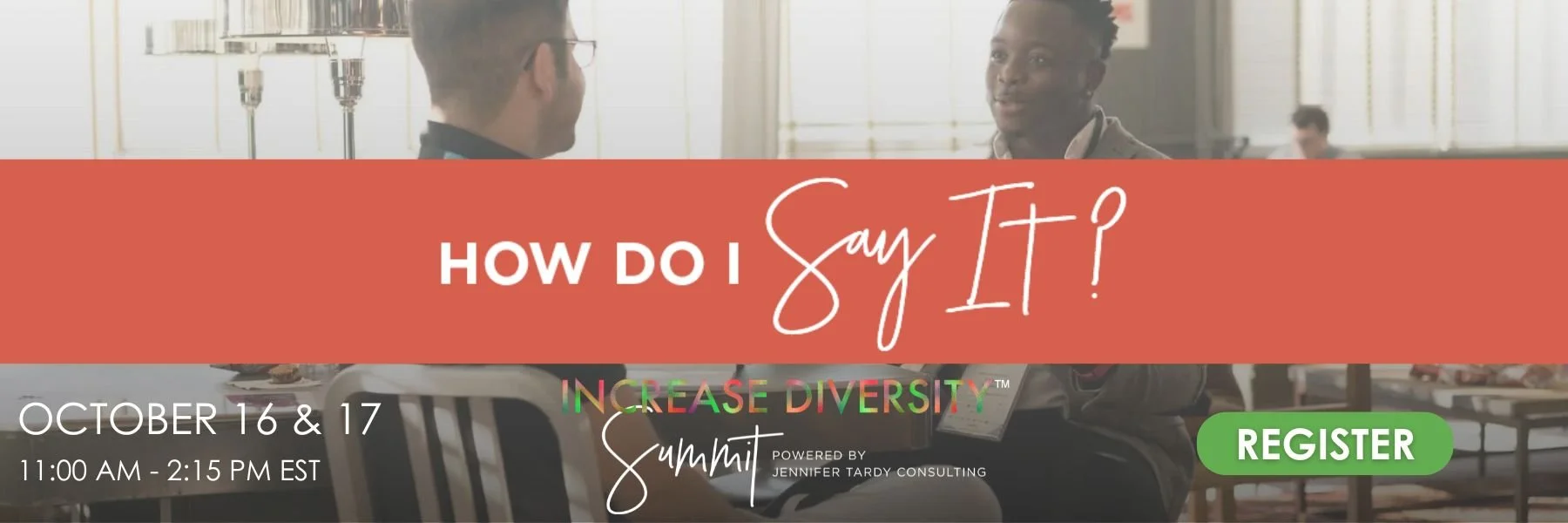The Most Important Factor to Increasing Diversity (It’s Not What You Think!)
This is #IncreaseDiversity, a weekly newsletter series + Increase Diversity Toolbox sharing best practices for employers who want to learn how to… well, increase diversity. To see previous editions, visit JenniferTardy.com. | IG: @IncreaseDiversity | Increase Diversity - YouTube
One of the most important topics we often discuss at Team JTC is language. The language we use is so important because it has the power to move us all forward or leave some feeling left behind and out of the conversation. The important work of increasing diversity often starts with using effective language.
Here, effective language means language that communicates an intended message. And ineffective language does the opposite: it communicates an unintended message. A part of your journey of awareness is leveraging effective language to move in the direction of being an ally and ultimately towards improving diversity and retention.
Language is super important, but there’s something that’s more important because language is just a part of it. This week, we’re diving into a topic that’s been brewing in the diversity recruiting world for a while: the number one prerequisite for increasing diversity that not many employers talk about. In fact, we have a video on this topic on our Diversity Recruiter Central. If you’re someone who prefers watching, be sure to check it out here.
But if reading is more your style, here’s a quick summary:
Recognizing Your Internal Team's Hesitation
We’re convinced that the external tactics you share with your hiring managers and recruiters to increase diversity—none of that matters until you help them resolve what’s happening on the inside. You’ve got to work with what’s on the inside first before you start telling people to do things externally.
But what do I mean when I say “work on the inside” and “prerequisite”? It means many of your recruiters, hiring managers, and even the interviewers on the expanded interview team do not feel qualified, capable, or comfortable talking about diversity, such as what terms to use.
That’s because they don’t want to end up saying the wrong thing. Should I use “African American” or “Black”? Latinx or Latino? “Disabled” or “a person with disabilities”? If I look in the wrong place, ask the wrong question, or say or do the wrong thing, am I going to be labeled a racist? Am I going to get my company sued? These are normal human feelings.
Positioning your recruiters and hiring managers on the front lines and telling them to “go and increase diversity” is no different than any other scenario where individuals don’t feel qualified, capable, or comfortable.
If we don’t feel equipped with the right tools to be qualified, capable, and comfortable, we tend not to lean in, and we do not engage. Even if we engage, we tread lightly. This hesitancy is the major reason why organizations haven’t been effective in increasing diversity. This internal fear leads many to step out of the conversation altogether.
During a webinar organized a few years ago, someone asked me: “How can a hiring leader determine who on their team needs additional support on the inner work?” And my response was this: “Everyone.” The recruiting leader should assume that everyone could use the support, no matter who they are or how they identify. But what does support look like?
Support starts with training. And by the way, support is the bedrock of what makes our training programs at Jennifer Tardy Consulting so unique. We not only help to deliver the tools you need for the external work, we also process what’s happening internally in two of our different training programs.
So, whether you decide to go through JTC or another agency for your training, make sure you’re thinking about this prerequisite.
Overcoming Resistance: The First Step of a Diversity Recruiting Strategy
Speaking of internal work, one of the areas we focus on is resistance. Where do you feel the most resistance, especially when you think about people who identify uniquely to you? Being able to name the resistance, get more specific, and then put that resistance in context are the first big steps toward understanding the type of support you need.
And remember, support is individual and everyone needs it. The support is generally around how to help people to resolve unresolved inner feelings around not feeling qualified, capable, and confident about doing the work of increasing diversity.
Overall, the secret to increasing diversity lies not just in external actions but in tackling internal fears and uncertainties. Giving recruiters and hiring managers the confidence and knowledge to have conversations around increasing diversity might be the first step you need to take in your initiative. Focus on this by providing training that digs deeper into identifying and overcoming resistance. And remember, everyone needs support.
JOIN ME IN THE COMMENTS: In what area do you feel you need more internal work or more support to navigate those internal feelings? Drop me a comment in the comment section, and let's get a conversation going that way.





